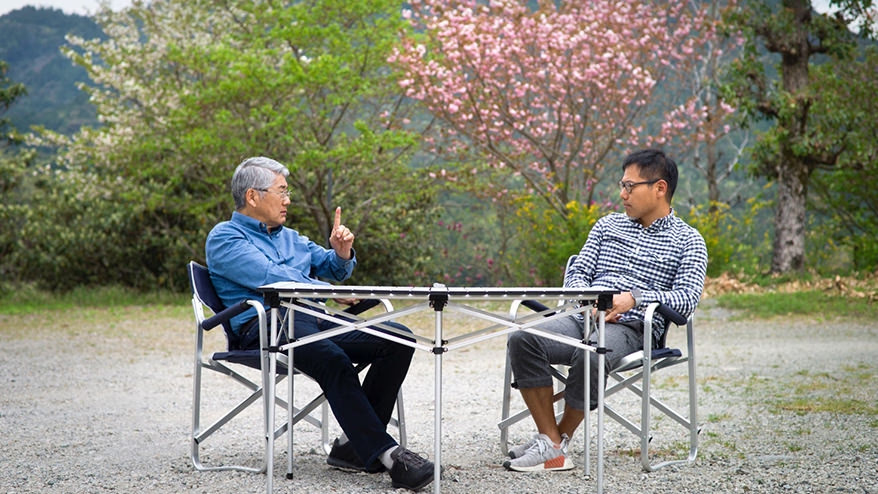Appearing on this edition of Meguru Measuring Ruler is Oonami Shinya.
Kamiyama Town in Tokushima Prefecture continues to attract attention as a model region among the various regions in Japan that are revitalized by regional revitalization. In Kamiyama, Ominami is the chairman of the certified NPO Green Valley and plays a central role in town development.
Green Valley's motto is "Making Japan's countryside beautiful," and they are primarily involved in projects centered around art and relocation support, such as the "Artist in Residence " program, which invites artists from Japan and abroad to Kamiyama, the "Work in Residence" program, which allows people to relocate with their jobs, the "Kamiyama Academy" which provides support training for jobseekers, and attracting satellite offices.
After graduating from graduate school in the United States, Ominami returned to his hometown of Kamiyama, where he continued to run the family civil engineering business, while also becoming the mastermind behind a business with an eye to the future of Kamiyama.
It was in the fall of 2012 that Ominami and Monosus' representative Hayashi met.
The unique atmosphere that permeates the entire town of Kamiyama, and the words "Why not just do it?" uttered by the people of Green Valley, led by Ominami-san, inspired Hayashi, who visited to inspect the area, and the connection between Kamiyama and Monosus rapidly deepened.
In 2014, Manabe from the Production Department, one of the members who visited for the second time, moved to Kamiyama with his family. While searching for new ways of living and working, he launched his own project, the " Food Hub Project ."
In 2015, with the support of Mr. Kidoin of Relations, who is also a director of Green Valley, we started the Monosus version of "Kamiyama Juku" as part of our job seeker support system. Many members have joined Monosus since then.
Then, in January 2017, the operations team officially began operating at the Kamiyama satellite office , where they are now responsible for website operations.
The more connections we made, the more we realized that the reason why more and more companies are setting up satellite offices in Kamiyama, why people are settling here, and why new projects are being launched one after another is because of the idea that "why not just do it?"
In this episode of Meguru Measashi, Hayashi will be the interviewer, and will be digging deep into how the spirit of "Just do it" has taken root and spread in Kamiyama, speaking to Ominami, a key figure in Kamiyama. We will be delivering the details of this in two parts.
(Interview: Kensaku Saguchi, Photography: Katsutaka Ikuzu)
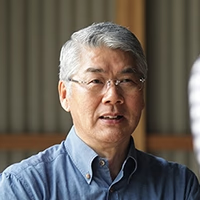
Profile of Shinya Ominami :
Born in Kamiyama, Tokushima Prefecture in 1953. Graduated from Stanford Graduate School in the United States. After returning to his hometown, he practiced "resident-led town development" with his friends, and in 1996 began "creating an international artists' village." He launched a series of art projects, including the "Adopt Program," a road cleaning activity that was the first of its kind in the country, and the "Kamiyama Artist in Residence."
In 2004, he founded the nonprofit organization Green Valley and became its chairman. He supports relocation and business start-ups and promotes the establishment of satellite offices. He advocates "creative depopulation," which is a creative depopulation, and has promoted the creation of "Kamiyama of the World," a place where diverse people gather.
"Just Do It" = "Why not just do it?"
Decide for yourself the distance that is neither too close nor too far
HayashiRecently, a topic has come up that I'd like to ask Ominami -san about again. That's the origin of "Why not just do it?"
Oonami-san: Yes.
Another phrase I recently found interesting is that of the French philosopher Jean-Paul Sartre, who said, "Man is condemned to freedom."
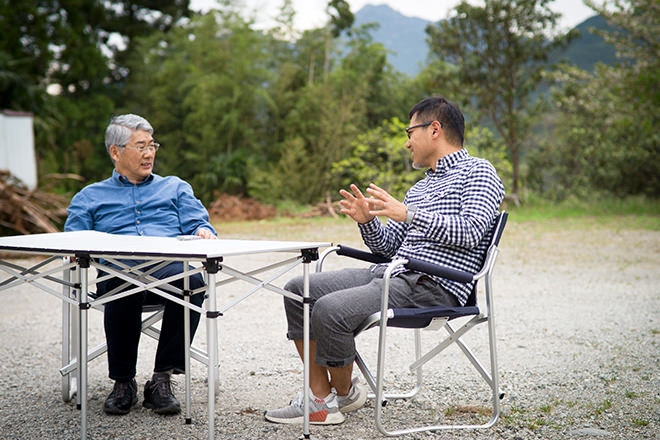
Ominami-san, are you free? That's difficult.
Hayashi: It's difficult, but people are not given their roles by God, and they must define their own meaning of existence. But they don't know what to choose from the infinite options that will allow them to become who they are. I interpret him as saying "the punishment of freedom" to describe the harshness of such freedom.
And it seems that the harshness and difficulty of the situation is increasing year by year. For example, all the workers, including Monosas, are wondering why they are working and whether they really chose their current situation. With an infinite number of options, it is becoming unclear.
I myself was in exactly the same state when I came across the idea of "Why not just do it?" in Kamiyama, and I think that's what drew me to this place.
I see, Oonami-san .
Based on what I felt at Hayashi Kamiyama, I started talking about "Let's have our own project" at Monosus. It's an initiative that puts my own thoughts into my work. One of them is the "Food Hub Project" (hereinafter referred to as Food Hub), which is led by Manabe Taichi, and other members are starting to get involved little by little, but it's not spreading very far.
However, in Kamiyama, based on the spirit of "why not just do it," one after another, personal projects are being launched and spreading.
That's right, Oonami-san .
Hayashi
The reason I created a satellite office in Kamiyama was because I thought that if I could bring everyone in my company closer to Kamiyama, they would all start their own projects. I've recently been thinking that it was this premonition that drew me to Kamiyama.
So, this introduction was quite long, but this is why I want to know the origins of Kamiyama's "Why not just do it?"
In addition, I came here today hoping to hear from Ominami-san about how an environment like Kamiyama can be created, and to incorporate the aspects that can be structured.
Oonami
Hmm.
First of all, "Why not just do it?" is an irresponsible statement. It's dismissive. But I feel like that dismissive feeling might actually resonate freshly now.
You can get as much information as you want if you look into it, and the world is so convenient, but they take a step back and say, "You do it on your own," but they're also supportive. I wonder if this makes kids who are starting something feel less cramped and more able to express their thoughts directly.
I think it's all about human distance. If you're too close, it's suffocating. Conversely, if you're too far, you become estranged. I think there are surprisingly few places where you can maintain a comfortable distance for each person. I feel that Kamiyama is a place where you can decide that distance for yourself, more so than other places.
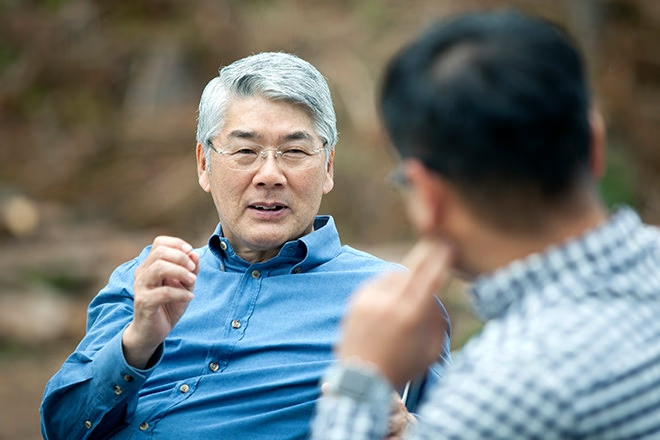
Hayashi: First of all, when did the phrase "Why not just do it?" come into use?
Oonami
This is a dialect, so the word itself has been around for a long time.
When did people start saying, "Why not just do it?" in the same way that Hayashi Tainan and his colleagues use the term?
I think it was around the time Ominami-san's " Kamiyama School " started. It seemed to come out of the conversation during the interview. Originally, Green Valley had two guidelines and ways of thinking called the Green Valley Way.
"Rather than the reasons why you can't do something, think about how you can do it!" "Just do it!" I was wondering how "Just do it" would translate into Kamiyama dialect, and the answer that came to mind was "Just do it!"
Because we have a network that supports us as a business, we can say, "Why not just do it?"
If it fails, it's an "experiment."
HayashiIn fact, being in Kamiyama, you get the sense that the "why not just do it" mentality is deeply rooted. Whenever someone, not just someone who has moved here, tries to start something new, the people of Kamiyama will push them away with a "why not just do it" mentality, but will also help them out in various ways, with an excellent sense of distance.
Ominami: For example, when I heard from Kanazawa of " Licht Licht " that he wanted to open a custom-made shoe store in Kamiyama, I couldn't say, "That's a great idea, so go ahead and do it." But he had a plan and said, "I want to do this!"
Rather than stopping these young people from other places from taking action, we give them a small opportunity to try things out, saying, "Why not give it a try?"
Even if it fails, don't label it as a "failure" but call it an "experiment". As time goes by, the circumstances may change and it may work again. If you are afraid of failure and frame things as no good and no good, only predictable and ordinary things will happen.
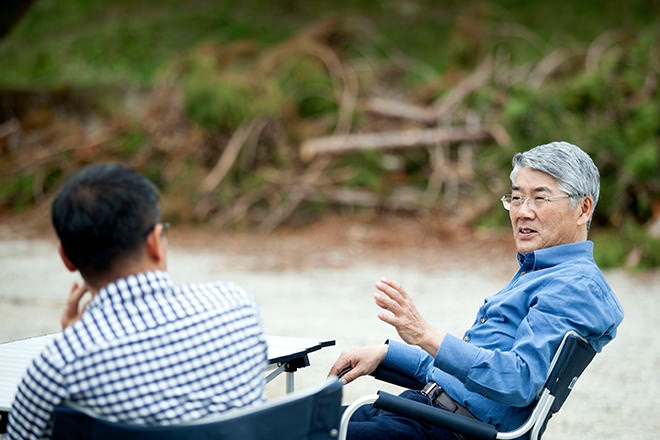
Usually, in other regions, the government helps people start a business by providing subsidies. At Green Valley, we help with the business operations after the business has started.
For example, if Kanazawa-kun opens a shoe store, I'll be a customer, but at the same time, I'll promote it by saying, "This kind of store has opened in Kamiyama." There are people in the community who understand that it's not just about using government money or whatever to get things moving, but that using networks to get things moving is actually the most important thing.
Hayashi
Is it a network?
Ominami: Exactly. We think about who should play what role to make each business successful. Rather than just supporting the start-up, there is a network within the community that creates a cycle that makes the business run, so I think that's why the idea of "why not just do it" is working.
Hayashi: Did you have a network that allowed you to make use of that "why not just try it" attitude from when you were young?
Ominami-san, no. Places like Kamiyama are inherently conservative. The most reassuring situation is for things to continue as they have been up until now.
Did Ominami- san, who just came back from America, make this?
When Ominami-san came back from America, he would always say things like, "America is an interesting place," and people would always say, "That guy's getting crazy." So, for a few years after he came back, he watched from the countryside to see how the world was moving.
If you stand out, you're always going to be called "American-obsessed." It's annoying to be told that. So, while I was devoting myself to my work, I was constantly watching how things happen and progress in the countryside. When new movements get crushed.
In the end, the countryside is a cramped society. A cramped society is, in other words, a world without gaps.
A world without forest gaps.
Even if Ominami-san tries to do something new and opens his arms, he is told, "That's no good. There are things that have been decided for a long time." He is also young, so he doesn't like this kind of restrictiveness. Especially after living in California for two years. It's a very free city. There are no external restrictions. As for the weather, it doesn't rain at all from mid-April to mid-September. Outdoor activities are never cancelled. It's a place where everything moves according to plan.
Hayashi
yes.
Ominami-san had really grown his wings in that kind of environment, so it must have been painful for him to keep them in that state for so long. So after a good bit of man-watching, he and his friends started to push the boundaries of what was around them in the countryside little by little.
I pushed the frame hard so that I could move freely. Then, a gap appeared between me and the frame. This gap gave me some freedom of movement. I gradually widened it.
Hayashi is amazing. By the way, what was your first step?
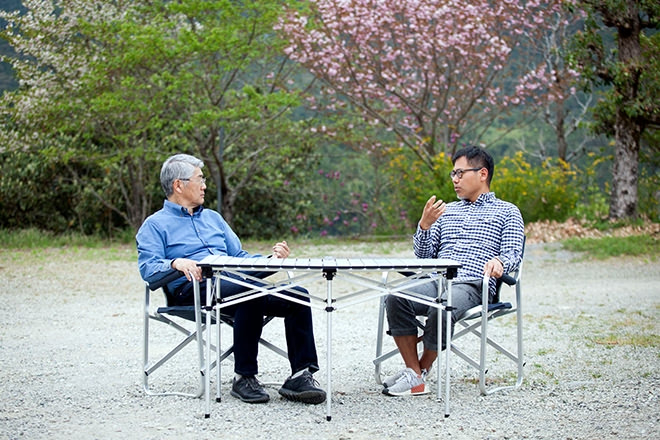
Oonami
The first step was when I was talking with two of my Green Valley friends, Hideo Sato and Kiyoshi Iwamaru, about going on a trip abroad and we decided that we needed to learn English. With that as our justification, I think it was around 1981. We started something like an English conversation class at the Kamiyama Town Rural Environment Improvement Center.
The first students were Hideo-san, Kiyoshi-san, and some people from the town hall. A year later, I told them, "You won't know anything until you get out," and took them to Singapore. Looking back, that was the first step.
After that, we started going almost every year. For example, we went to Hawaii with our family. All of my friends liked to try new things, so we started doing things like going to America for two weeks to play golf. At first, I wondered why people in Kamiyama would take the trouble to get on a plane to America to play golf when there were three golf courses just a 15-20 minute drive away.
Hayashi: How did the adults at the time react?
At first, Ominami-san is seen as an oddball, doing something unusual, but when unusual things happen continuously, it becomes part of the scenery. The viewers get used to it. It becomes like, "Oh, here we go again."
When you do that, it starts to seem less unique. In fact, I think this is the most important thing in building a community.
Back then, we were going out and training the people around us.
The strategy for community development adopted by Kamiyama was as follows:
Suddenly inviting people from all over the world
Oonami
After that, around 1988, I did a program where students from the Vienna University of Music and Performing Arts in Austria did homestays in Kamiyama. At that time, because I was also running an English conversation school, people started volunteering to stay in my home, and I started accepting students.
At that time, foreigners suddenly came to the local community. At first, many people were hesitant, saying, "I won't be able to speak the language." However, from around 1993, Kamiyama began hosting training for ALT teachers *1 who were assigned to elementary, junior high, and high schools in municipalities in Tokushima Prefecture every year, and foreigners began to seem less unusual.
*1 ALT: Assistant Language Teacher. The government has been inviting university graduates from English-speaking countries around the world to Japan under the "Foreign Youth Invitation Program for Language Teaching, etc." since 1987.
As you enter the village and try to drink with the people, you get used to it and it becomes part of the scenery. At first it bothers you, but then it doesn't bother you anymore. This creates the foundation for accepting diversity. And this diversity in turn fosters tolerance.
"Well, even if our way of thinking is different, it's fine if people like that exist," I think the accumulation of these experiences is what created the atmosphere and soil of Kamiyama.
So Hayashi Tainan also gradually expanded the boundaries.
Oonami
Little by little, we pushed the boundaries of the countryside, creating gaps there and securing freedom. Then, we and the people who live there feel more comfortable. Also, because local people like us are the first to show extreme examples of what has changed, I think it had the effect of making it easier for the children of immigrants to blend in later. I didn't calculate it. Just as a result.
Hayashi
In that sense, Kamiyama in the past was no different from other areas.
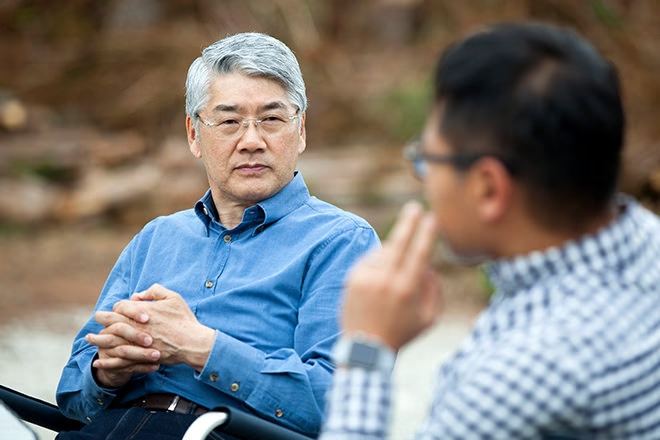
Oonami
I think the basics won't change. Conservative countryside.
Hayashi
Then, another question came up. I'm currently renting a house quite far from the satellite office in Jinryou, but even there I can feel the gap and freedom that Ominami and his team have expanded. I wonder how it has spread to the whole of Kamiyama, not just among a select few people.
Oonami
I think that if each individual changes little by little, even if it's just a few people each year, then over the course of 10 or 15 years, that will have a considerable impact.
For example, when we started the Kamiyama Artist in Residence , it was always the girls from Tokyo who came and said, "Oh, something interesting has started." Girls from Tokyo in their 30s came and told us, "Kamiyama was interesting." In this way, people who heard about Kamiyama from three or four different sources will then take action and say, "In that case, let's go."
That's how information spreads, and at first, the local people just look at it and think, "They're doing something strange." But, for example, when I go to a relative's memorial service in Tokushima City, people around me say, "Kamiyama is amazing these days. You're on TV a lot." That's when I first think, "What?" The closer you are, the slower the information spreads. But the change will surely spread.
Hayashi
funny.
Ominami: The strategy that Kamiyama has adopted for regional development is not to think of it as a region moving from one region to another, but to suddenly invite artists from all over the world. This is a good method in a way, because if you create a trend from an extreme place, it will definitely spread throughout the country.
Moreover, since we are now in the IT age, I think it is the regions that can make the biggest leap forward. Regions that have been left behind due to a lack of means to disseminate information now have the means to overcome that in one fell swoop.
Hayashi
When did you start to think, "It's about time I started branching out a little bit bigger"?
Ominami-san has always been pushing the boundaries. The standard for how to expand has changed, for example with the " Adopt a Program" for road cleaning activities.
*2 The Adopt-a-Highway program originated in 1985 when the Texas State Highway Department asked residents along the highway to clean up trash and other debris, and has since spread throughout the U.S. Adopt means to adopt, and it is a system in which local residents adopt and maintain roads and parks constructed by national and local governments, as well as rivers and coastlines that have been managed by them.
Hayashi : I've heard this before, but the first episode of Adopt was amazing.
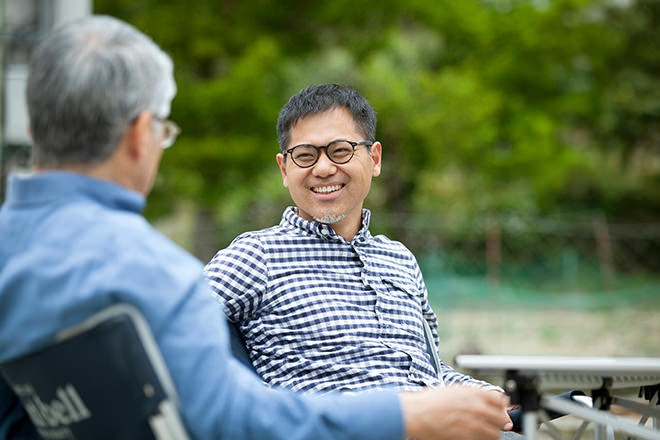
Oonami-san, at first, the administrative barriers were so thick...
"We are very grateful for the cooperation of the private sector in beautifying the roads, but when it comes to signs with sponsor names on them, it is difficult due to the Road Act, which prohibits their use for commercial purposes," he said, giving one reason after another why it couldn't be done. He suggested that it would be okay to put up signs on private property beside the road, but he only got an answer that it would be considered. No matter how long he waited after that, he never heard back from them about the results of their consideration. So he decided to make up his mind. He put up his signs without permission on a total of 8 kilometers of private property beside the road.
Hayashi
Did you install it overnight?
Ominami: No, I did it secretly on the weekends when the road patrol was off. Laws are supposed to be there to make the world a better place. I pushed through by asking the public, not the government, to decide whether it was right or wrong. In the end, the prefecture asked me to remove it, but I just said, "I'll remove it, but please give me an order to remove it." Then, once the order was issued, I was thinking of calling the media.
We tried to clean up the town with our own efforts, put up signs with sponsors' names on them, and carried out cleaning activities, but the prefecture said it was not allowed because it violated the Road Law. What will newspaper readers and TV viewers think? I was thinking of asking the media to broadcast a video of us tearfully pulling out the signs (laughs).
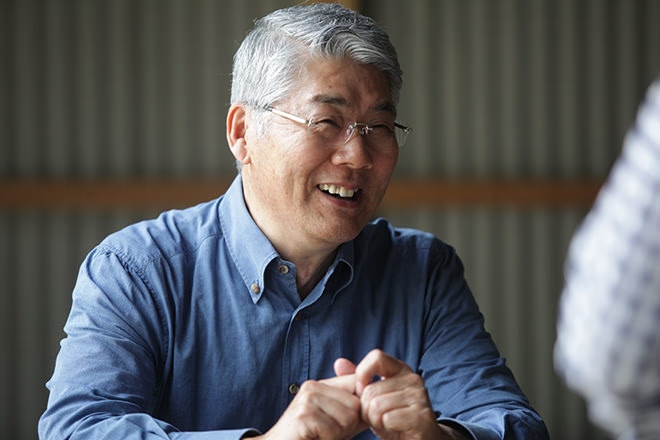
Hayashi
What happened?
The people of Ominami prefecture gave their tacit consent out of parental love.
It seems that they decided to turn a blind eye to it, since it's a good thing and doesn't cause any harm to people walking by. However, we wanted to expand not only within the prefecture, but nationwide, so that people would associate "Kamiyama with adoption." However, if we turned a blind eye, we would never be able to expand nationwide. So we used the time bomb we had set.
Hayashi is a time bomb.
Of the seven billboards that Ominami had originally erected, three were intentionally erected in road areas, not on private property. When he leaked this to a newspaper reporter, the article "Problems in road areas. Prefecture to request relocation soon" was published, and the billboards made the front page of the social section. By that time, they had become part of the scenery, so local people were very interested in them.
From there, a table was set up with the prefecture to explore ways to do it, and the Tokushima Prefecture OUR Road Adopt Project was launched as an official project in October 1999. It became a standard and spread not only to Kamiyama, but throughout Japan.
It feels like the forest framework has been greatly expanded.
Ominami: I still make a model under my own responsibility and show it to the government. Usually, I explain it on paper in a proposal, but people find it hard to believe when you tell them in words, "If you do this, this will happen." Government officials, in particular, tend to want to avoid risk, so I've thought about that and made it a practice to show them the model first.
If you make a small model and show people the phenomenon that occurs around it, they'll say, "Oh, I see." It all makes sense. Seeing is believing.
If you can convey how you are dealing with things, there will always be people who respond. Those people are exactly the people Kamiyama needs.
Ominami-san: There was an NHK program that helped make the Kamiyama satellite office famous nationwide. There was a scene where people were working on laptops on the riverbank and videoconferencing with the head office. It was an NHK director's idea to film that, but it was shot in 2012. But Wi-Fi signals have been broadcasting on that riverbank since 2007.
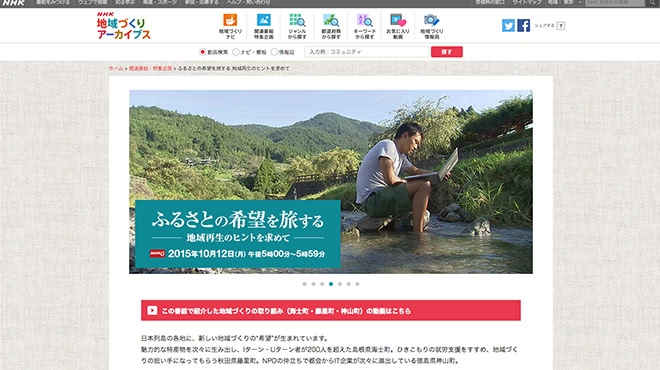
NHK Community Development Archives: Traveling to the Hopes of Hometowns in Search of Hints for Regional Revitalization
https://www.nhk.or.jp/chiiki/program/151012.html
Hayashi
This is quite early considering that the iPhone was released in the same year, 2007.
Ominami-san also pushed the boundaries with his attitude of "Why not just try it?"
At the time, when we talked about broadcasting Wi-Fi signals to that location, the local government responded by saying, "Ominami-san, if 10,000 people were to come to Kamiyama, how many of them would come to the riverbank with their laptops?"
When I replied, "Maybe around 10 people, and of those, maybe only one person will actually open a computer," he seemed to think, "It's a waste to have equipment that 10,000 people come in and only one person uses it."
However, that's not how we think. What I mean is that there are always people who respond to the information that there are people trying to do something similar to what Google is doing in Mountain View, where its headquarters is located, in a rural area of Japan like Kamiyama. And they say that those kinds of people are exactly the kind of people Kamiyama needs.
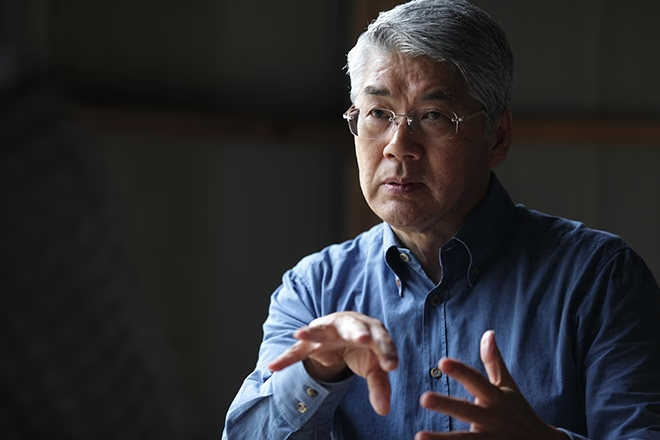
Because it was Hayashi , I thought, "Why not just do it?"
Oonami: There's absolutely no need for the Wi-Fi signals being transmitted here to reach anyone's laptop, but if they do reach those people, then that's a good thing.
In fact, in an interview with a magazine, President Terada of Sansan, the first company to set up a satellite office in Kamiyama, said, "Even if Sansan doesn't come to Kamiyama, I'm sure some venture company will find it here someday."
This means that the information we sent out through "Why not just do it?" reached the people who needed it, and they took action.
What people in this world tend to do is to simply spread information in an attempt to get everyone to know about them and buy their products.
But the most important thing is how the source of the information is facing things. In the end, even if it takes time, when that attitude is conveyed, the customers who want what they want the most will take action.
Most people misunderstand this point. The value of something depends on whether the creator has a philosophy or can communicate who they are. If they don't have that, they can't differentiate themselves from others, so in the end, they'll just get lost in the cold.
Hayashi
That's why Wi-Fi needs to be available on the riverbank by 2007.
Ominami : Exactly. The seeds were planted, which led to the NHK footage, which then attracted other people. Various seeds were planted all over the place, and they happened to sprout at a certain time and in a certain environment.
You could say that sowing the seeds is my own project, and because we've continued it ourselves, I think we can say to people from outside, "Why don't you give it a try?"
To be continued in the second part .
